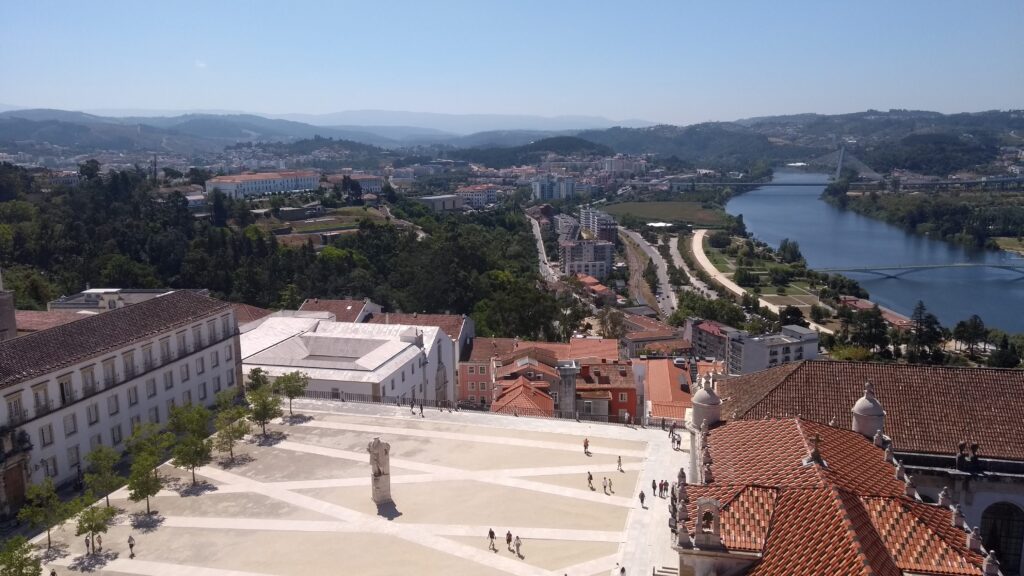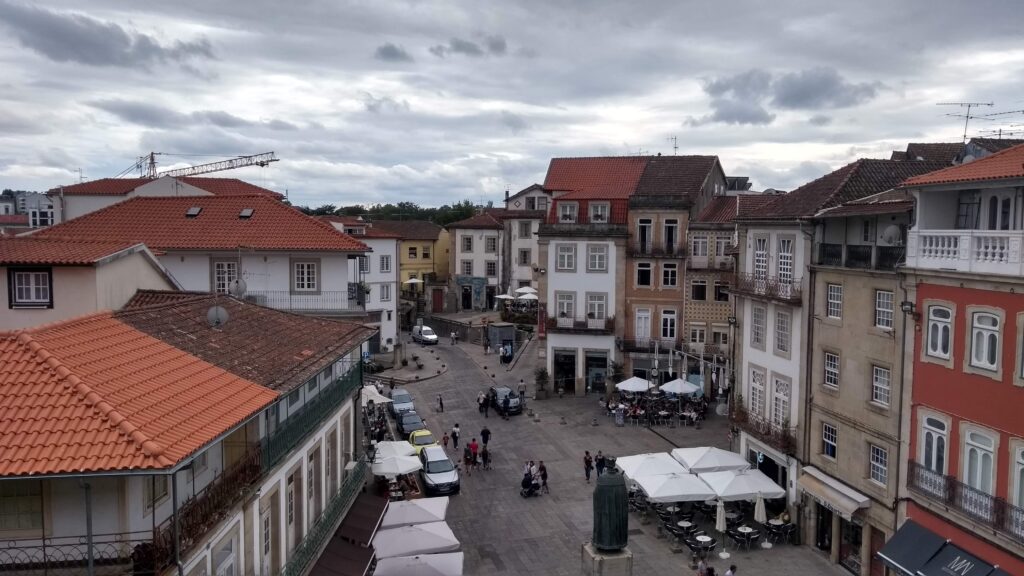Discover the charm and history of Lisbon
This post will guide you through the oldest part of Lisbon, the city of natural light. When you made this city tour by yourself, you will discover why Lisbon is called the city of natural light. You also will learn why I normally only call this city Lisboa. Why I say that there is no other name for this city. Read this post and discover the charm and history of Lisboa.
"The history of Fado"
through this city tour, you will discover the history of Fado, the typical Portuguese music. The music that is the expression of the Portuguese way of living, a Saudade. When you follow this city tour, you will pass through the cradle of the Fado, in Mouraria.
"The labyrinth of Alfama"
The small streets of Alfama tell us more about how Lisboa was built up before the earthquake of 1st November 1755. In this neighbourhood, you also get an impression of the Moorish influence in the city and maybe one of the most picturesque postcard viewpoints of Lisboa.
"Important Portuguese personalities"
In São Vicente, we visit some important personalities of Portuguese history. Like the royal family, the diva of the Fado, a famous football player and cenotaphs of important people in the Portuguese maritime discoveries.
What are the topics of this post?
keywords:
#lisbon, #lisboa, #oldcitytour, #fado, #alfama, #tourguide
Travel Information
Travel time:
At least 3-4 hours
Distance:
8 km
Start:
Praça da Figueira
Arrival:
Praça do Comércio
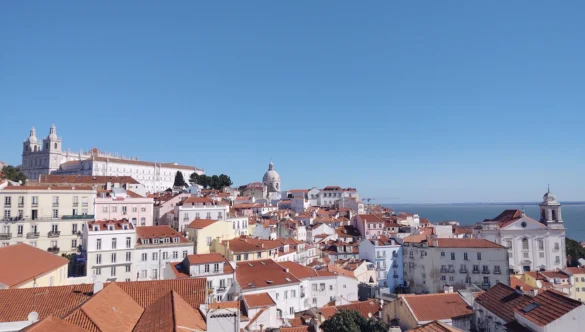
What do you need for this old city tour?
Comfortable clothes
"Wear comfortable clothes"
When you're gonna make a walking tour, it is a good idea to wear comfortable clothes. It isn't needed to wear a tight shirt when you feel yourself more comfortable in loose-fitting clothes like a t-shirt, polo or sporty clothes. Wear clothes to feel yourself comfortable for walking, climbing and enjoying the moment.
"Good walking shoes"
Lisboa is not a flat city. It is built on 7 hills. When you make this old city tour, you're gonna walk to some of them. The historic part of Lisboa also has a lot of squares and streets with cobblestones and not all the small streets are well flat paved. So to walk through Lisboa, it is a good idea to wear comfortable closed shoes to walk. A comfortable sneaker, sporty shoe or a sturdy closed shoe is good enough. For women, avoid heels in Lisbon.
Good health
This is a walking tour of around 8 km through the historical part of the city, with a lot of climbing to high located viewpoints. So, it is great to be in a good healthy condition. For some streets, it is possible to take an alternative route without stairs or that is less steep. But this is not possible for every street of this old city tour.
Something to drink
When you plan to make a city tour or road trip, it always is a good idea to have something to drink with you. Of course, in Lisboa you have enough shops, kiosks, pastelarias, paderias and so on to buy something to drink. But it is not bad to have some small drinking bottle with you. Just in case.
Good mood
"Be happy and feel the vibe"
Last but not least, start a city tour with a good mood. Be happy, be amazed about the wonderful things you will see and discover. Relax and go into the moment. Immerse yourself into the local wonderful atmosphere of Lisboa. Feel the typical vibe of the city and enjoy.
The charm and history of the Lisbon old city tour
What to see when you walk through the old city of Lisboa?
"Fado, picturesque Alfama and important personalities"
Follow this city tour and walk through the charm and history of Lisboa. With this walking tour you will walk through the cradle of the Fado, the typical Portuguese music. The small streets of Alfama tell us how Lisboa was built up before the earthquake of 1755. Here you also can enjoy some picturesque postcard views. You'll get a short impression of the Moorish time. In São Vicente, visit some important personalities of Portuguese history. Finally, the tour ends on the large Praça do Comércio at the wide Tagus river. The whole tour has around 10 viewpoints over the city and river. But to start this city tour, you have to be on Praça da Figueira.
START AT PRAÇA DA FIGUEIRA
"The central market square of Lisbon"
Praça da Figeuira is a central market square in the city. It is located aside of Praça Dom Pedro IV, also known as Rossio. In the history Praça da Figueira was the home of an impressive market hall to sell fruit, vegetables and poultry. Now, almost a whole year long you still find some small selling stalls at this square where they sell hand made stuff.
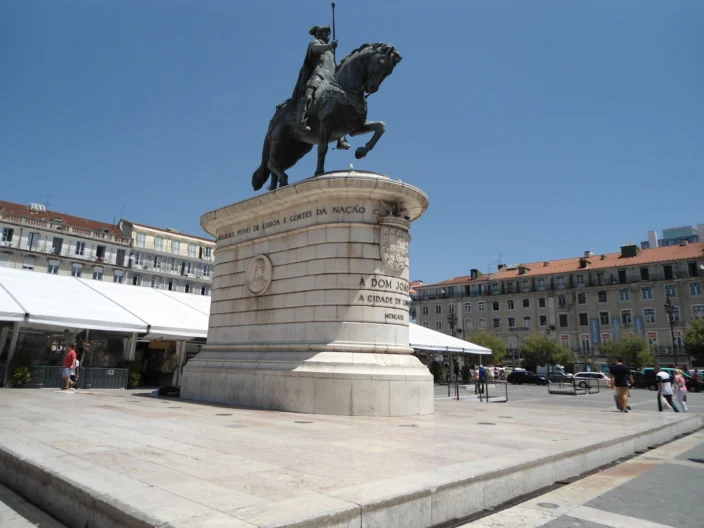
"Mercado da Baixa"
Some moments in the year, you find the Mercado da Baixa on Praça da Figueira. A market hall with a lot of local food products. It is a market with a wonderful vibe and atmosphere. When it is possible, take a moment to visit this wonderful open air market.

"Statue of King Dom João I"
The statue you see is of King Dom João I, King John I. King João I was the king of Portugal with the longest reign of Portuguese history. He was king for 48 years in the 14th and 15th century. João I is recognized for his important role to preserve the independence of Portugal and he saw the start of the overseas expansion of Portugal.
How to walk further?
From Praça da Figueira, with the Tagus river behind you, take the street left of the square: Rua Dom Antão de Almada. This is the small street parallel to the Praça Dom Pedro IV (Rossio).
Church of São Domingos
"A gloomy and ghostly church"
This church was part of a Dominican monastery and dates from the 13th century. Due to different facts it was needed to rebuilt this church many times. It also was 2 times destroyed.
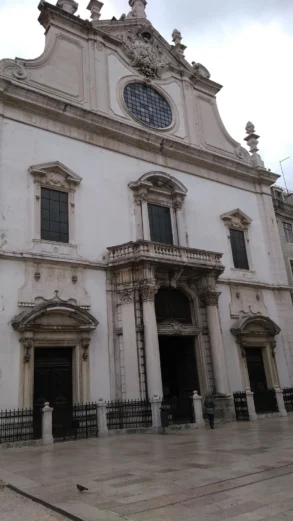
"Destroyed by the earthquake of 1755"
The earthquake of 1st November 1755 destroyed this church for a first time, except of one chapel. This earthquake destroyed the whole city of Lisboa.
"Burned down in 1959"
In 1959, this church burned down completely. In the church, you still can discover the fire damage and burn marks on the marble, statues and pillars. Also the floor is gone. These are now part of the interior. They give the church a gloomy and ghostly look and feel.
A Ginjinha
"Cherry liqueur is famous"
In front of this church, you find "A Ginjinha". These kind of small bars where you can taste "Ginja", a cherry liqueur are very famous in Lisboa. You find more of them elsewhere in the city. But, A Ginjinha is the most authentic one. A Ginjinha is known as the first Ginja-shop in Lisboa.
How to walk further?
Go into the small street in front of "A Ginjinha". This is the Rua das Portas de Santo Antão. The next stops are located in this street.
HIDDEN GEMS
"Discover some hidden gems in the city"
Casa do Alentejo
"A hidden palace"
At number 58 in the Rua das Portas de Santo Antão, you see the letters "Casa Do Alentejo". I suppose you don't may expect it, but this is an old Moorish palace. The other name of this building is "Alverca Palace". Now there is a restaurant and the headquarter of the association of the Alentejo people.
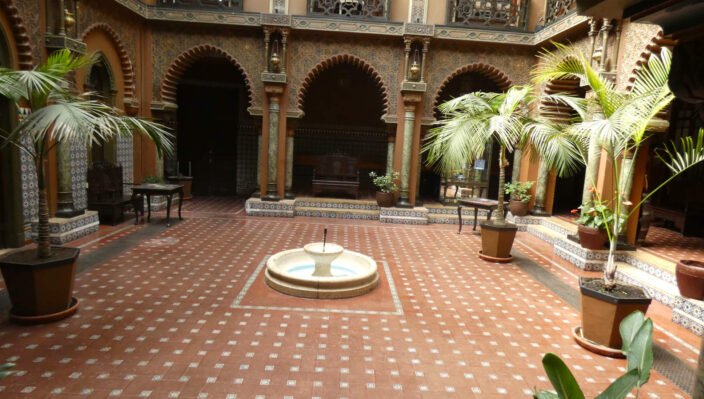
O Coliseu
"Theatre hall in the center of the city"
This is a theatre hall for many different kinds of performances. The main scope is for musicals and Typical Portuguese musicians. Also many international artists and organisations give the best of themselves on stage in the Coliseu. As well as in the Teatro Politeama at the other side of the street.
Lavra Elevator
"A hidden funicular"
At the end of the street, is one of the 3 funiculars located, Lavra Elevator. These are old city trams used as elevator. In the past, the 2 cabins work as a counterweight of each other. Now they work on electricity. You can take this tram upwards to reach our next stop.
How to walk further?
It is possible to reach our next point of this old city tour in 2 ways:
- Take the Lavra Elevator upwards. Above go further at your left side to reach Jardim do Torel.
- Another way to reach Jardim do Torel is by walking. At the Lavra Elevator, go straight forward into the Rua São José. At the crosspoint, turn right into the Rua do Telhal. A little bit furher, at your right side appears a gate with stairs. This is a side entrance of Jardim do Torel. Go inside and the stairs upwards.
JARDIM DO TOREL
"Hidden garden on the rooftop of a school"
This is one of the most hidden gardens in Lisbon, with a wonderful view over the city. This is our first viewpoints on this old city tour.
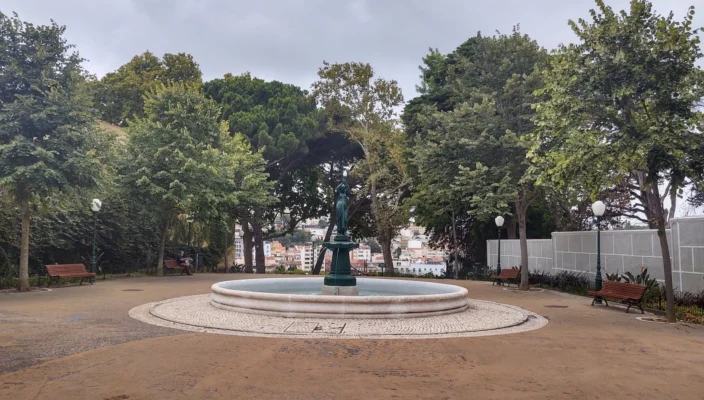
"A city garden in different levels"
Jardim do Torel is a charming garden built up in different levels. It is built up on the roof of a school. The aspects of this garden are:
- Nice views over the Avenida da Liberdade and the city
- A park
- A Terrace
- A pond on the rooftop of a school
Still not too many tourists. Yes indeed, you're right. Maybe it is not a good idea to inform you about this garden. Because, when more tourists discover this hidden garden, it maybe will not stay a relaxed garden in the city. So, ssst! Don't tell it to much further. Keep it for yourself.
"Swim in the pond"
But in the summer time, it is not as relaxed as other moments in the year. At some evenings in the summer, the pond in this garden transforms into a swimming pool and a sort of a beach. So, Jardim do Torel becomes a nice place to stay. But, ssst! Don't tell it many times further. Keep this information for yourself. That is the ideal way to preserve the charm of this garden.
How to walk further?
Now we walk further to reach Martim Moniz and Mouraria as the cradle of the Fado. But this is a huge walk down. Here are the walking instructions to reach these locations from Jardim do Torel:
- From the main entrance of Jardim do Torel, go right and at the end left.
- Walk straight forward to the end through the Traversa Torel.
- At the end, again turn right and follow the Rua Instituto Bacteriológico.
- After the corner go left, down into the Calçada Santana. You'll pass the Igreja de Nossa Senhora da Pena, a church on your right hand. Go further straight forward down the street.
- At number 32, you have to turn left.
- Finally, again turn left into the Rua Arco da Graça.
- At your right side, you can take the stairs down to Martim Moniz. This is the square where you can take the historic Tram 28.
- Cross the square and behind the chapel, take left.
MOURARIA: BERÇO DO FADO
"The cradle of the Fado"
Mouraria is the neighbourhood on the walls of the castle and known as the cradle of the Fado, the typical Portuguese music. Fado is the musical expression of the Portuguese way of living, a Saudade. In this post, you can read more about the Saudade. Below we go further about the charm and history of Mouraria.

Berço do Fado
Oppostie the shopping center of Mouraria stands a statue with the letters "Mouraria Berço do Fado", or in English: Mouraria the cradle of the Fado. The Rua do Capelão aside of this statue is known as the street of the Fado. Decorated with a lot of paintings of many famous Fadistas out of the history if Fado. When you walk further through this street you discover at the end 2 Fado houses. These are the houses of one of the most important Fadistas of Lisboa.
"Maria Severa"
The house on your right hand is the house where Maria Severa lived till here death. Maria Severa is known as the first Fadista of Lisboa who became famous. She also is known as "A Severa" and has a colourfull wall painting at the other side of Mouraria.
"Fernando Maurício"
Opposite this house, stands the house where Fernando Mauríco was born and lived as a child. Fernando Maurício is known as "o Rei do Fado" (the King of Fado). His statue stands a little bit further in this neighbourhood, in the Rua da Guia.
Feel the vibe
When you walk over Largo Severa and through the Rua da Guia, you feel the typical atmosphere and vibe of this neighbourhood. Sometimes, it can feel like you are catapulted back in time. This is one of the greatest charms of this neighbourhood. Did you know that at this moment this is one of the safest neighbourhoods of Lisboa? Yes it is.
How to walk further?
Now we go further to reach 3 wonderful viewpoints in Graça. The steps below guide you to these places in the city:
- First take the small Rua da Amendoeira in front of the Rua da Guia.
- At the end turn right to follow the Calçada de Santo André.
- When you reach Largo Rodrigues de Freitas, follow left to take the Calçada da Graça.
- At the end, you reach the Jardim da Graça and the following 3 wonderful neighbourhoods.
GRAçA
"3 Wonderful viewpoints"
Welcome in Graça. Here you find 3 wonderful viewpoints. The Portuguese word for viewpoint is "miradouro". Enjoy the most wonderful views over Lisboa and take a seat to eat and drink something. Relax and enjoy your time. That are some keywords of Graça why many tourists like this neighbourhood.
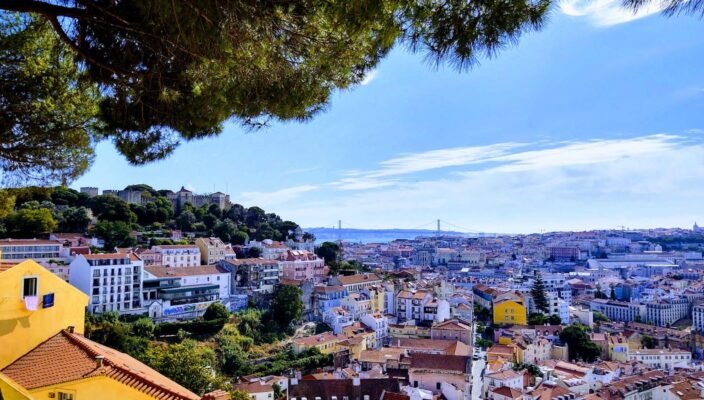
"Miradouro da Graça"
First of all, the most famous and popular viewpoint is Miradouro da Graça. Because here you get a nice view over the city. In front of you, you see Martim Moniz and the Berço do Fado in Mouraria. While at your left, appears the castle. Further away, you see the 25 April bridge. This bridge connects Lisboa with Almada, at the other side of the river.
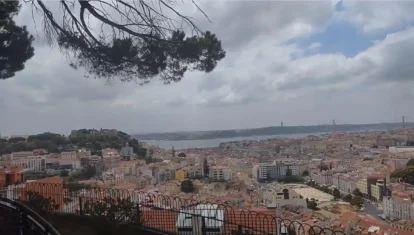
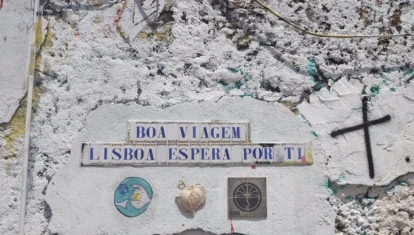
"Miradouro da Nossa Senhora do Monte"
On the highest point of Graça is the viewpoint Nossa Senhora da Monte situated. This is one of the highest viewpoints in the city. From this viewpoint, you have a view over the whole city. When you are here, take a short break to relax and enjoy the moment.
"Jardim da Cerca da Graça"
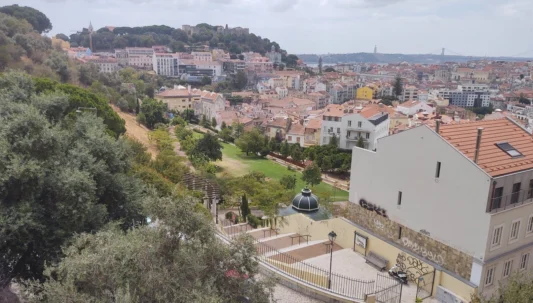
A little bit lower is the Jardim da Cerca da Graça located. It is a nice garden with a kiosk. Ideal for a break, to relax and take something to eat and drink while you enjoy the nice view over Lisbon.
How to walk further?
Afterwards go further down to São Vicente. The steps below tell you how to reach this place:
- Again cross the Jardim da Graça to follow the small Traversa São Vicente.
- Turn right, to follow the Rua da Voz do Operário.
SÃO VICENTE
"Important personalities"
In São Vicente, you can visit the final resting place of a lot of famous personalities of Portugal. Some are cenotaphs. This means that you only see a place which is a memoriam, but the body is laid somewhere else.
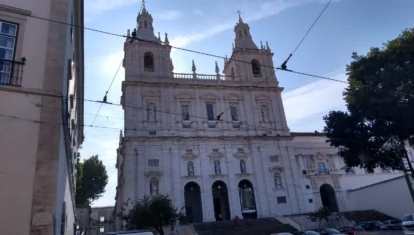
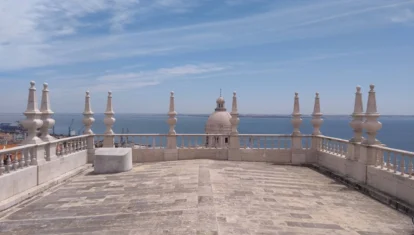
Church and Monastery of São Vicente de Fora
This is the church of São Vicente, one of the two patrons of Lisboa. Aside of this church, stands the Monastery of São Vicente de Fora. This monastery holds the tombs of the most important royal family of Portugal: The house of Bragança. When you visit this monastery, you can visit these tombs without extra cost. Also, walk on the roof of the church to get a great view to the Pantheon National and the wide Tagus river.
Pantheon National

Behind this church and monastery, stands the Pantheon National. This building is built on an octagonal floor plan and at the place of a previous church. Inside the Pantheon National, you discover cenotaphs and tombs of the most famous personalities of Portugal. Buy a ticket to go inside and see cenotaphs of Vasco da Gama and Luís de Camões. As well as the tomb of the Diva of the Fado, Amália Rodrigues. For sport lovers, also visit the tomb of maybe the best football player in Portuguese history, Eusébio.
"Feira da Ladra"
After the National Pantheon and around the Mercado Santa Clara, you can walk every Tuesday and Saturday between handcrafted goods, fun and vintage items, and kitsch. Ideal if you want something special to decorate your house.
How to walk further?
Now we go further to maybe the most famous and picturesque neighbourhood of Lisboa: Alfama. Follow the steps below to reach the charm and history of Alfama:
- In front of the Curch of São Vicente de Fora, take the small Rua de São Vicente.
- At the end, turn right to follow the Rua São Tomé.
- Go further in this street to reach the charm and central squares of Alfama.
ALFAMA
"The charm and history of old Lisbon"
Alfama, the most picturesque neighbourhood of Lisboa. With a lot of charm and history of the old city. Here you discover Lisbon as it was before the earthquake of 1st November 1755. A labyrinth of small streets. But also many viewpoints and monuments. Read further below to learn what you all can see in Alfama.
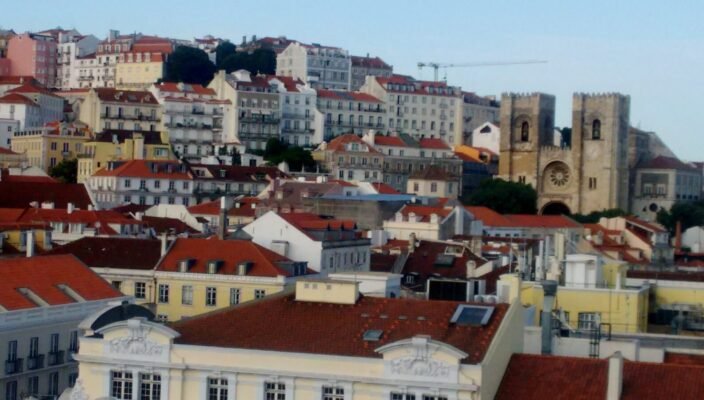
Castelo São Jorge
A castle standing dominant in the city, that is the Saint George Castle, o Castelo São Jorge. Devoted to the Christians after the reconquista on the Moors. When Lisbon became the capital of Portugal, this castle became the Royal Palace. The castle is located on the highest hill of the city. So, it has the most wonderful views over the city and the river. This was very important in the history to protect the old Lisboa.

Picturesque postcard views
Walk back down from the castle, take the Traversa do Funil, cross the Largo do Contador Mor to finally go into the small Traversa de Santa Luzia. Now you reach 2 of the most famous viewpoints of Lisboa.
"Miradouro de Santa Luzia"
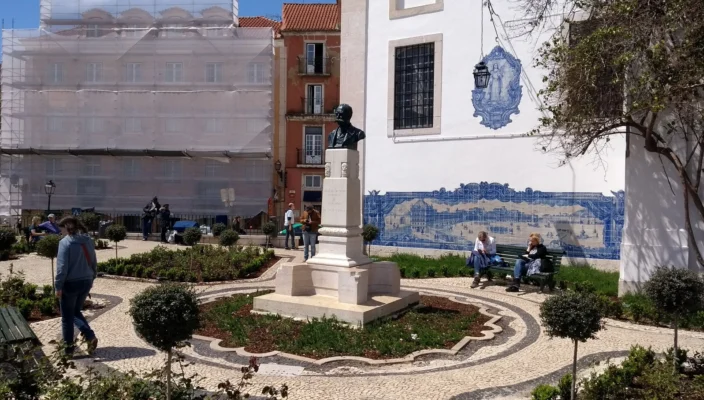
In front of you, is Miradouro de Santa Luzia situated. On this viewpoint you have a nice patio with wonderful azulejos and great views over the old Alfama and Tagus river. The wall of the church has 2 impressive Azulejos panels. One tells the history of the reconquest of Chrisitans on the Moors in the castle. The other one is an image of the Praça do Comércio before the devastating earthquake of 1st November 1755. At the other side of the miradouro, you also discover a 3rd azulejos panel. Here you see Lisboa as you may discover it these days.
"Miradouro das Portas do Sol"
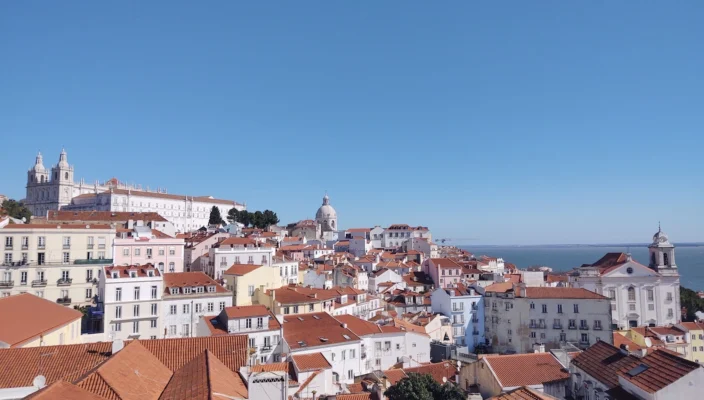
At the other side of the Church of Santa Luzia is another viewpoint situated. This is Miradouro das Portas do Sol and is known that it maybe has the most picturesque postcard view of Lisboa. See the image below or better visit this viewpoint and I will decide it for yourself. The name comes from an old gate in the Moorish city wall that stood here. In the middle of this square stands the statue of São Vicente, with in his hands a boat with 2 crows. As already told before, São Vicente is one of the two patrons of Lisboa. The boat with two crows is the coat of arms of Lisboa.
How to walk further?
Now I'm gonna lead you through the labyrinth of Alfama. Follow the route below to discover the charm and history of Lisboa. Immerse yourself into the old part of the city.
- Take the stairs down between the 2 picturesque viewpoints.
- Almost halfway, you have a tunnel at your left side. This is the tunnel of the History of Lisboa.
- Go through this tunnel and take the stairs down to reach the Berco da Santa Helena.
- Turn right and go down the next stairs.
- Take the 1st left into the Beco Garcês.
- At the end, again turn left to follow right on the Largo do Salvador.
- Go further over the Largo do Salvador to reach the Rua de Guilhereme Braga after the corner.
- Follow this street and you will reach the Largo do Santo Estêvão.
- Go in front of the church and you will reach again a viewpoint over the city. Yes again a tiny viewpoint.
- Take the stairs down to follow the Escadinhas Santo Estêvão. These go further on your left side over a tiny picturesque square.
- From this square, go further down on the small stairs to finally reach the Rua dos Remédios.
- Turn right on this street and follow to the end. In front of you appears the Fado Museum.
FADO MUSEUM
"Fado at the main square of Alfama"
The Fado museum is located in the lower part of Alfama, at the old Alfama Square. If you want learn more about Fado, then you have to be in this museum. But to really feel what Fado is, I suggest you to go out for dinner in a good Fado restaurant. The best and most original Fado experiences, you find in restaurants in Alfama or Mouraria. You also can go for Fado in Bairro Alto. But there you will find the more commercial restaurants and the Fado that became popular from the 60s of the 20th century. While Fado has its origin in the 19th century, around 1820.

Chafariz d'El Rei
Follow the river a little bit further from the right side of the Fado museum. Cross the Largo do Terreiro do Trigo to go further into the Rua Cais de Santarém. At your right side, you discover a fountain. This is Chafariz d'El Rei, the Royal Fountain.
"Important drinking water"
In the past, this fountain was an important source of drinking water in the city. Because it made use of the great water of Alfama and was built in the city wall of the 13th century. These days it is decorated with the coat of arms of the old Kingdom of Portugal in the middle. While you see the coat of arms of Lisboa, the boat with 2 crows, at the two side panels.
How to walk further?
We go back upwards to the last part of the Alfama. Follow these instructions below to visit the Cathedral and Saint Anthony.
- Walk further on the Rua Cais de Santarém.
- Take the first right, into the Arco de Jesus.
- At the end, take the stairs in front of you to reach the Rua São João da Praça.
- Turn left to follow this street and stay right to follow the Cruzes da Sé.
- At the end you arrive at the entrance of the Cathedral of Lisboa.
SÉ DE LISBOA
"Cathedral and Saint Anthony"
We reach the last part of Alfama before this old city tour takes an end at one of the largest squares of Europe. First, we still make a stop at the Cathedral of Lisbon and the Church of Saint Anthony.
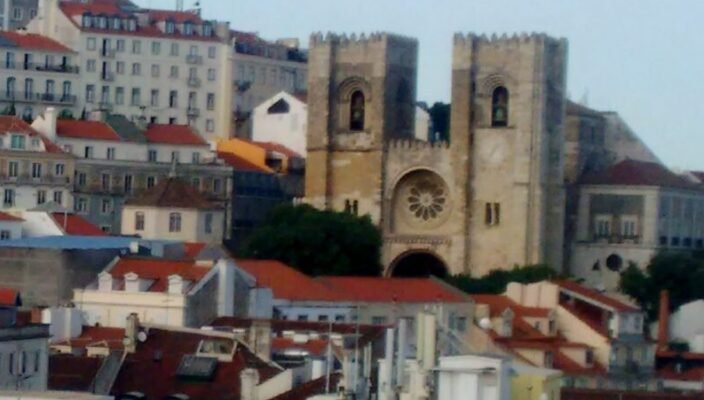
Cathedral of Lisbon
The Cathedral, in Portuguese "a Sé", is the oldest church in the city. It has a mix of different architectural styles. From a Romanesque style, some Gothic parts to a sacristy built in Baroque. Finally, some rebuilts were made in neoclassical and Rococo after the earthquake of 1755. Afterwards, the neoclassical decorations were removed to give the Cathedral again a more medieval appearance.

Church of Saint Anthony
This church was built on the place where Saint Anthony, or better Santo António, was born. Santo António lived in Portugal and Italy, where he died in Padua. So yes, Saint Anthony of Lisboa and Saint Anthony of Padua is the same person.
"The patron of the Lisboetas"
Santo António is the 2nd patron of the city and the patron chosen by the people themselves. He also is the patron of Portugal. Saint Anthony is the patron for all good things. People worship Saint Anthony for:
- a matchmaker for lovers
- good marriages
- protecting pregnant women
- elderly, poor and oppressed people
- sailors, fishermen and travelers
- lost objects
The Lisboetas are so proud on their own chosen patron, that they celebrate a whole month of June. This is part of the Festas dos Santos Populares. You can learn more about this huge city festival in our post about the June Festivities.
How to walk further?
Finally, go to the last point of this walking tour. This Lisbon old city tour takes an end at the largest square of Lisboa and one of the largest squares of Europe.
- Follow the main street further down where also the famous Tram 28 passes.
- Go straight forward into the Rua da Conceição.
- When you reach the Rua Augusta, the wonderful Arco da Rua Augusta appears on your left side.
- Go into this direction and walk under this impressive arch to reach the Praça do Comércio.
PRAçA DO COMÉRCIO
"A noble entrance to the city"
Here we stand on the largest square of Lisboa and one of the largest of Europe. Welcome on Praça do Comércio. By the locals, this square also is better known as "Terreiro do Paço". The metro station also has this name.
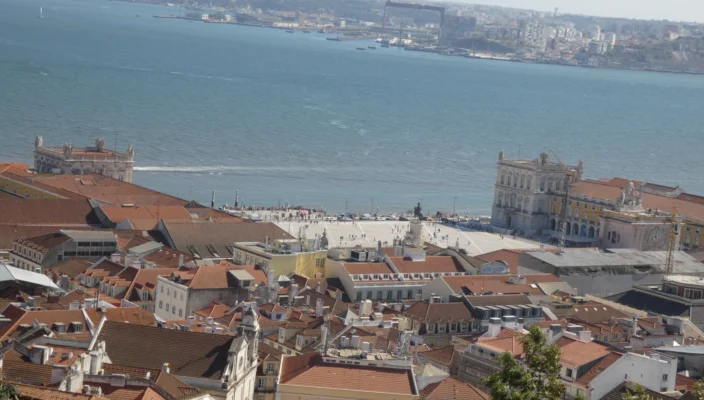
A charm and noble entrance to Lisbon
Praça do Comércio is located directly at the wide Tagus river. Yes, it is a river and not the sea. The square always was a place to trade fresh fish, as well as a charm and noble entrance to the city. Many high placed public figures arrived here on the Cais das Colunas at the Tagus river. Also on the old square, Paço da Ribeira, which was completely destroyed by the devastating earthquake in the morning of 1st November 1755 and the following tsunami.
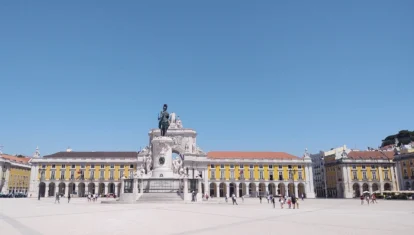
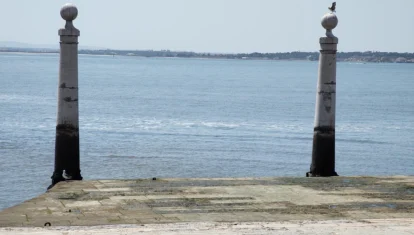
Fundamental in the rebuilt of Lisboa
For Marquês de Pombal, this was a fundemental square in the rebuilt of Lisbon after the earthquake. He wanted something that shows the strengths and the rebirth of the city.
"An impressive triumphal arch"
For me and many others, the Arco da Rua Augusta simolises this all. The arch is flanked by many important figures out of Portugal's history. While the Latin inscription on the top refers to the grandeur of the Portuguese Empire and the discovery of new peoples and cultures. While the yellow buildings are used for public institutions, governmnent departments, hotels, restaurants, bars and cultural activities.
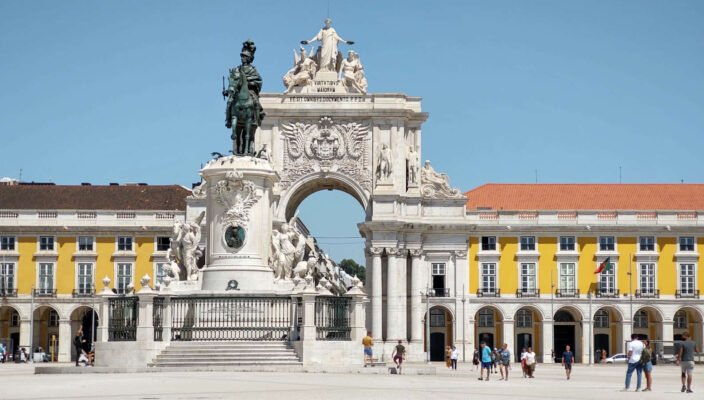
"Arch as a viewpoint"
Do you know that you can visit the arch as a viewpoint? When you go to the top, you have a great view over this square, the Tagus river, Baixa and Alfama with the medieval Cathedral in front of you. In the Lisbon Story Centre in the yellow buildings, you can immerse yourself into the history of Lisbon and Portugal.
King D. José I
In the middle of Praça do Comércio stands the statue of King Dom José I. He was King of Portugal from 1750 till 1777 and also known as "The Reformer".
Walk with a tour guide
Do you want to get more info when you walk through Lisbon, the city of natural light? In that case, it is a good idea to go with a tour guide. Due to the modern technologies, you also can go for an audio guide on your personal mobile device. This is the ideal way to get more information and walk at your own pace.
Smart Guide
It is possible to walk this tour with our free audio guide and your own mobile device. You walk through the city at your own pace, while I give you all the information in your ears.
Scan the QR-code or press the button and open our free audio tour in the mobile app of Smart Guide.
Book a guide online
Or book your tour guide through Lisbon online. You can go for a guide who walks with you through the city. Also other audioguides through Lisbon are available. Most popular online platforms to book a tour guide are Viator, part of Tripadvisor, and Get Your Guide. Discover more on their websites by clicking the button below.
Buy a compact digital tour guide
You also can buy a compact digital tour guide. This is the ideal way to stay informed, have all the essential information with you and don't worry about internet connections. We offer you the Voyageiro compact city guide.
Plan your city trip to visit the charm and history of Lisbon
Prepare yourself to discover the charm and history of Lisbon by yourself. Find your perfect flights and where you want to stay. A good preparation keeps the fun in your city trip. Or do you still need some more inside information? Read also our posts about Lisboa and the neighbourhoods of Lisbon.
Read More
"Selected for you"
You want to read more and get noticed about the posts ideal for you. Well, subscribe to our newsletter. This is the ideal way to stay tuned about all our posts and videos in the spotlight and selected for you.
The content of this page is copyright of Lindo Portugal.
© 2023 lindoportugal.eu
With media content of Galeria Sámuel.







